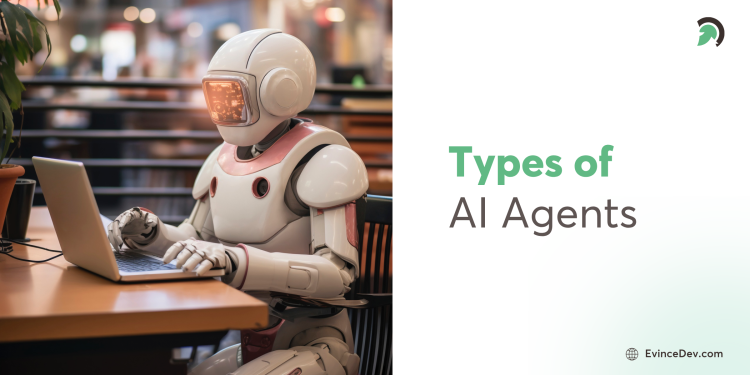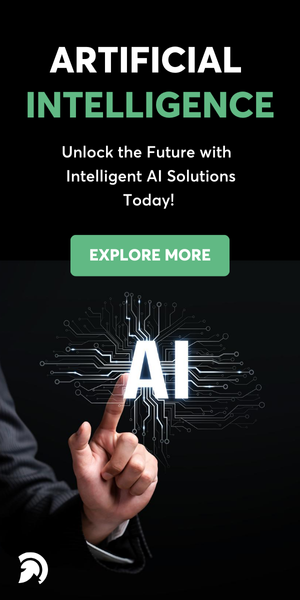Artificial Intelligence (AI) is no longer just a futuristic idea; it’s woven into the fabric of our digital lives. From software assistants that manage our calendars to intelligent algorithms that power recommendation engines, AI is making smarter decisions across digital platforms. At the heart of these systems are AI agents; the decision-makers. Understanding the types of AI agents helps us see how machines think, adapt, and evolve.
Whether you’re developing a new product, optimizing customer experiences, or exploring automation with AI app development, understanding how AI agents work can unlock smarter innovation.
What Is an AI Agent?
An AI agent is a system that perceives its environment and takes actions to achieve specific goals. Think of it like a smart GPS that constantly recalculates your route based on traffic, roadblocks, and your destination. AI agents can be as simple as a thermostat or as complex as autonomous vehicles. They observe, process information, make decisions, and act; mimicking how humans operate in various situations.
Core Components of an AI Agent
AI agents have four basic components:
- Data Inputs: Receive inputs from APIs, user interactions, logs, or digital sources.
- Output Handlers: Execute actions such as updating a user interface, sending emails, generating content, or triggering backend processes.
- Processing Unit: Uses logic, rules, or learning to decide what to do.
- Feedback Loop: Learns and improves based on outcomes.
Together, these parts enable the agent to function intelligently in real-world applications.
Types of AI Agents
AI agents are classified based on how they make decisions, how much information they retain, and how they adapt to new scenarios. Here are the five major types:
Simple Reflex Agents
Simple reflex agents operate solely on condition-action rules; responding to the current percept without considering history or future consequences. It follows predefined logic like “if this happens, then do that,” making them fast and efficient for straightforward tasks. However, they lack memory or learning ability, which means they cannot adapt to new situations or improve performance over time.
A common example is a spam filter that deletes emails containing specific keywords. While ideal for basic automation like firewall rules that block or allow network traffic based on specific IP addresses or ports, email auto-responders that send predefined replies when certain keywords appear in incoming messages, chatbots that answer FAQs by matching user input against a fixed set of keywords or phrases, and build systems that trigger compilation or tests only when files in specific directories are changed, they’re limited in dynamic or unpredictable environments where more intelligent reasoning or adaptation is required.
- Pros: Fast, efficient for simple tasks.
- Cons: Cannot handle unexpected scenarios or learn from mistakes.
- Use Case: Basic software automation tasks such as spam filtering, network traffic control, automated email replies, and build system triggers.
Model-Based Reflex Agents
Model-based reflex agents maintain an internal representation or model of their environment. This model allows them to track unseen aspects of the world and infer what’s happening beyond immediate perception. By combining current inputs with historical data, they make better decisions than simple reflex agents.
For example, A virtual personal assistant uses a session-based memory to avoid repeating suggestions or reminders.It offers greater flexibility and accuracy, especially in partially observable environments, but at the cost of increased complexity and memory use. They’re used in smart homes, warehouse automation, and more context-aware systems.
- Pros: More flexible and accurate.
- Cons: Requires more memory and processing power.
- Use Case: Home automation, warehouse robotics.
Goal-Based Agents
Goal-based agents focus on achieving specific objectives rather than just reacting to inputs. They evaluate various possible actions by analyzing how well each option helps achieve their goal. Unlike reflex agents, they can plan, assess future outcomes, and make choices accordingly. A common example is a GPS navigation system that calculates different routes and selects the fastest or most efficient one.
They are adaptive and task-oriented, making them suitable for applications like autonomous driving and strategic recommendation systems. However, they require more computational resources to process goals and search for optimal paths, which may slow them down in complex environments.
- Example: A GPS system that calculates the best route to your destination.
- Pros: Adaptive and focused.
- Cons: Computationally expensive.
- Use Case: Autonomous vehicles, e-commerce recommendation systems.
Utility-Based Agents
Utility-based agents go beyond simply reaching goals—they evaluate the desirability of different outcomes using a utility function. This means they can make trade-offs between competing objectives, selecting actions that maximize overall value.
For instance, a dynamic pricing engine might weigh factors like profit, conversion rates, and inventory levels to set the ideal price. These agents offer nuanced decision-making, especially in environments where there isn’t a single right answer. While they provide high-performance results, they depend on having well-designed utility models, which can be difficult to define accurately. They’re ideal for finance, customer service, and strategic planning applications.
- Pros: Smart decision-making with trade-offs.
- Cons: Requires a well-defined utility function.
- Use Case: Financial planning tools, advanced customer service bots.
Learning Agents
Learning agents are designed to improve performance over time through experience. They include components that allow them to modify behavior based on feedback from the environment. Initially, they may make mistakes, but by learning which actions lead to better outcomes, they become more effective.
A good example is an AI-powered writing assistant that gets better with each use, adapting to the user’s tone and style. Agents are especially useful in dynamic or uncertain environments, such as fraud detection, predictive maintenance, or personalized marketing. Their ability to adapt makes them powerful, but their learning phase requires careful monitoring to ensure they don’t adopt undesired behaviors.
- Pros: Adapts to complex environments.
- Cons: Can make errors during learning phase.
- Use Case: Personalized marketing, fraud detection, predictive maintenance.
Specialized Classifications of AI Agents
In addition to these primary types, there are more specialized agents:
Collaborative Agents
These agents work with other agents or systems to achieve shared goals. They coordinate actions, share knowledge, and often operate in distributed environments, making them ideal for team based problem solving in logistics, simulations, or multi agent platforms.
Interface Agents
Interface agents interact directly with users, learning preferences and assisting with tasks. Common examples include virtual assistants like Siri or Alexa. They prioritize usability and personalization, adapting over time to better support individual user needs.
Mobile Agents
Mobile agents can move across different networked environments or systems. They perform tasks remotely, reducing bandwidth use and enabling decentralized computing. This flexibility is valuable for network management, data collection, or distributed software updates.
Hybrid Agents
Hybrid agents combine features from multiple agent types such as learning, goal based planning, and utility assessment to handle complex tasks more effectively. They are versatile and robust, suitable for dynamic applications like robotics, autonomous systems, or smart ecosystems.
It show how AI agents are evolving to handle increasingly complex tasks.
Real-World Applications of AI Agents
These advancements are reshaping how businesses approach AI app development services, providing scalable solutions across sectors like e-commerce, customer support, and smart devices.
E-commerce
AI agents in e-commerce use personalization engines to analyze browsing history, purchase behavior, and preferences. They recommend relevant products, improving customer experience and boosting sales. These agents adapt over time, learning from each interaction to refine suggestions, enhance engagement, and support marketing strategies like dynamic pricing, upselling, and customer segmentation.
Customer Support
In customer support, AI-powered chatbots handle inquiries instantly and around the clock. They use natural language processing to understand questions and provide accurate, context-aware responses. These agents reduce response time, improve customer satisfaction, and free human agents to focus on complex issues. Over time, they learn from interactions to improve their service quality and accuracy.
Software Development
AI agents assist developers by generating code snippets, identifying bugs, and optimizing performance. They streamline tasks like testing, debugging, and documentation, significantly reducing development time. These agents can learn from large codebases and patterns, offering intelligent suggestions and ensuring better code quality. It leads to faster, more efficient software delivery with fewer errors.
Smart Devices
In smart homes, AI agents power devices that adapt to user preferences and environmental conditions. They control lighting, temperature, security, and more by learning user habits. It ensure comfort, energy efficiency, and convenience, responding in real time to inputs from sensors or voice commands, and creating personalized living environments.
Enterprise Systems
Enterprise systems use AI agents in predictive CRMs (Customer Relationship Management) to analyze customer data and forecast behavior, a key benefit of AI development services tailored for modern businesses. It identify sales opportunities, suggest next-best actions, and personalize outreach strategies. They help businesses proactively address customer needs, boost retention, and improve decision making through data-driven insights and continuous learning.
At EvinceDev, we build AI-powered solutions that leverage the right type of agent architecture for each use case.
Future Outlook: Multi-Agent Systems and Adaptive AI
Future of AI agents lies in collaboration and self-adaptation. Multi-agent systems, where multiple AI agents work together, are solving problems in logistics, autonomous fleets, and smart manufacturing. Meanwhile, self-adaptive agents can tweak their strategies on the fly, making them ideal for dynamic environments. Ethical considerations, transparency, and interpretability will also be critical as these systems become more autonomous.
Empowering Innovation Through Intelligent Agents
AI agents are the backbone of intelligent systems. From simple automation to complex decision-making, understanding the types of AI agents helps businesses choose the right tools for the job. Whether it’s improving user experience, streamlining operations, or innovating with intelligent apps, AI agents make it possible.
Ready to integrate AI-driven intelligence into your next digital product?
EvinceDev’s AI experts can help design and deploy smart systems that learn, adapt, and perform. Contact us today to get started.




